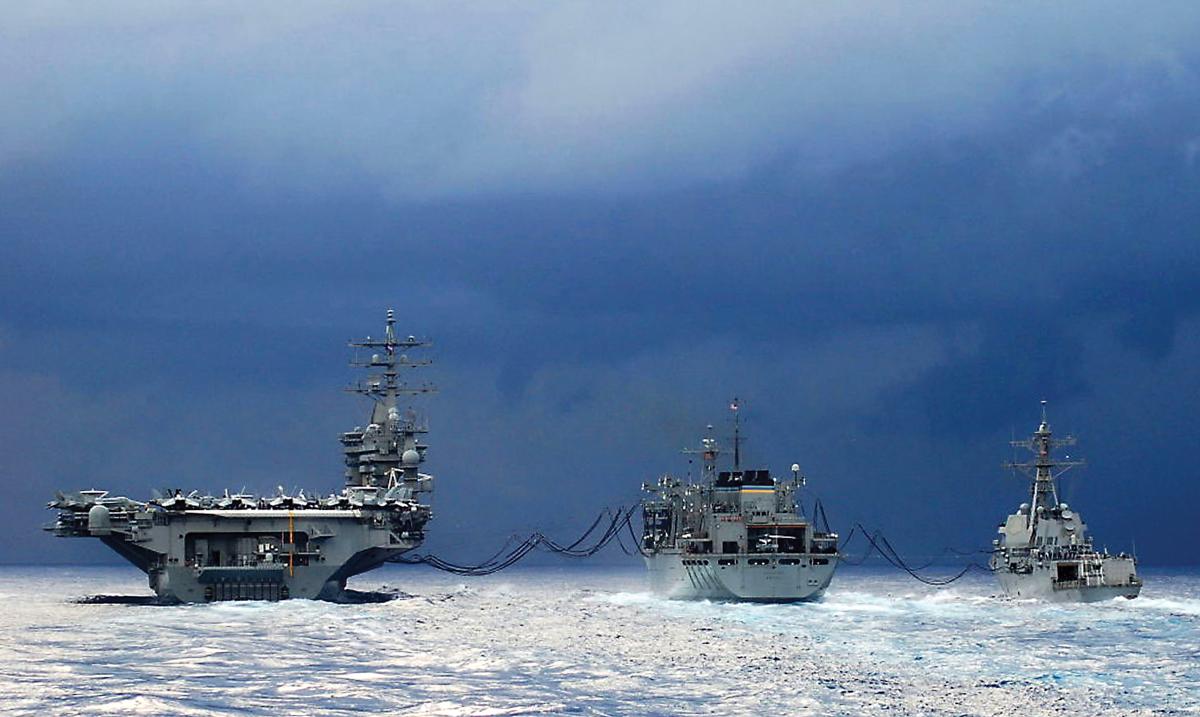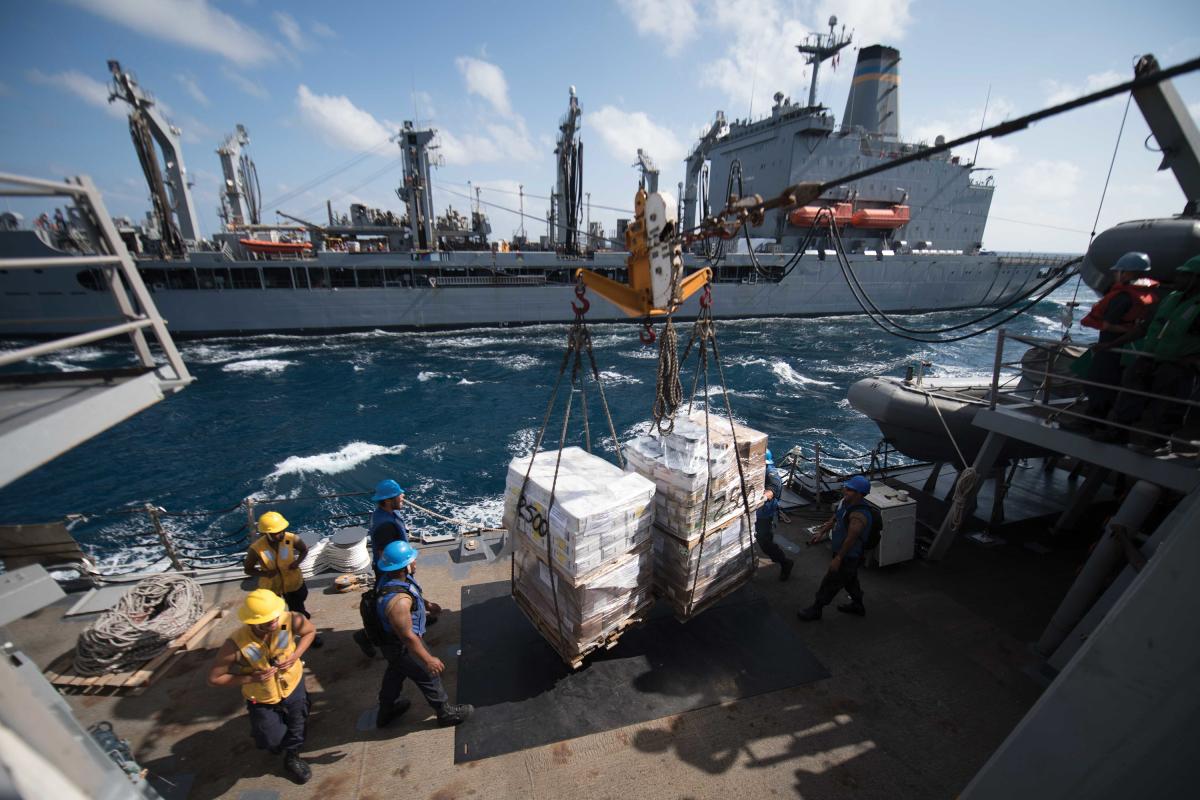The Chief of Naval Operations’ recent strategy document, “A Design for Maintaining Maritime Superiority,” calls for the fleet to be agile and ready for high-end combat. With the return of great power competition and the potential for armed conflict with an adversary that possesses the tools of full-spectrum naval warfare, is today’s Combat Logistics Force (CLF) ready? Manned and operated by the Military Sealift Command (MSC), a federal civilian agency, the at-sea logistics force of replenishment ships represents a critical vulnerability for the Navy and its ability to conduct prompt and sustained combat operations at sea.
The vulnerability of the CLF comes from three sources: low inventory of ships, no means of self-defense beyond small arms, and operational limitations resulting from civilian manning.
At 31 hulls, the oilers and multiproduct replenishment ships charged with sustaining the globally deployed Navy are just too few in number. The loss of even a few would have a significant impact on the Navy’s ability to stay and fight at sea. As such, these ships represent high-value units that must be defended, demanding a level of escort almost equivalent to that required to protect the Navy’s aircraft carriers.
The Navy will not possess sufficient surface combatants to meet this demand signal, even if it reaches its goal of 355 ships. While some of the escort requirement can be mitigated by operating CLF ships, specifically replenishment ships, in formation with the carriers to take advantage of the carrier’s escort screen, only two ships in the inventory—the Arctic-class fast combat support ships—have the speed to keep up with a carrier strike group. Further, when the CLF ship has to depart station to refill its fuel tanks and stores, a certain number of surface combatants would have to depart the screen to protect the oiler, depleting the “ring of steel” around the carrier.
In addition, it is not prudent for a task group to steam into battle with its supply ships in company. In World War II, during the great sea battles in the Pacific, the fleet replenishment ships cleared the area and operated to the rear of the battle space. Even then, they were well protected by an extensive screen of destroyers, destroyer escorts, and escort carriers.
Combat losses notwithstanding, the number of CLF ships is insufficient to keep warships topped off with the “beans, bullets, and black oil” they would need in high-intensity combat. Fuel consumption and ammunition expenditures in combat historically have far exceeded what was projected and planned for in peacetime. Currently, it is not unusual for a single logistics ship to serve an entire geographic theater. The tactical vulnerability and logistical insufficiency of this situation is self-evident.
Should the Navy attempt to address this vulnerability by significantly increasing the number of ships in the CLF, manning this force would be problematic at best. The past few decades have seen a steady decline in the number of professionally licensed civilian mariners in the United States—a direct result of the continuing constriction of the U.S. shipping industry and its declining share of global trade.
Were the required numbers of civilian mariners holding U.S. citizenship found, the Navy’s ability to sustain itself still would be in doubt. The CLF ships owned and operated by MSC as civilian-manned vessels are subject to restrictions on their employment in a combat zone. Proponents of the current MSC construct will point to more than two decades of successful combat zone operations that have met all the Navy’s requirements, but the primary threat in these combat zones was an asymmetric terrorist threat ashore, with a limited maritime threat in the littorals. High-end naval combat, not seen since World War II and to be expected in a great power conflict, would entail sustained attacks by enemy aircraft, submarines, surface ships, missiles, and sea mines. This will test the mettle of even the uniformed Navy. How a civilian crew would fare is subject for concern. This is not to question the courage and patriotism of civilian mariners, but they are not military personnel and are not trained as such.
Proponents of the current MSC construct also may point out that, if necessary, a civilian-manned MSC ship operating in a combat zone could be redesignated from a USNS ship to a USS ship and a Navy officer placed in charge as captain. However, a military detachment for self-protection notwithstanding, this ship still would be civilian manned from the ship’s master on down. To protect their legal status, the civilian crew cannot participate directly in combat operations. Does refueling and rearming ships fall into this exclusion?
Finally, the U.S. Merchant Marine’s illustrious record of courage under fire during World War II may be cited as proof of the efficacy of the current civilian MSC construct, but today’s civilian mariners are not the functional equivalent of the U.S. Merchant Marine in charter or organization. In addition, with few exceptions, the Merchant Marine did not man the Navy’s CLF ships but rather sailed the civilian cargo ships that moved in convoy under naval protection.
Compounding the vulnerabilities of today’s logistic ships is their lack of self-defense beyond a small uniformed security force equipped with small arms to protect against pirates or terrorists—hardly sufficient defense against bombs, missiles, and torpedoes.
Organize for the Fight
High-end naval combat will require a Combat Logistics Force that can sail in harm’s way facing air, surface, and submarine threats and defend itself. There must be enough ships in the inventory to absorb the inevitable losses and still be able to provide sustained support to the Navy at sea. The past is instructive here.
During the height of the Cold War, the CLF was an integral part of the U.S. Navy: manned by uniformed personnel, armed with an array of self-defense weapon systems, and equipped with the same communications gear and versed in the same tactics, techniques, and procedures as the rest of the Navy. After the demise of the Soviet Union, the CLF ships and mission were turned over to MSC. The weapon systems and much of the military-specific communication gear were removed from the ships, and with the elimination of Navy crews, the CLF became disconnected from Navy tactics and operational concepts, such as operating under restricted radar and communication emissions
Going forward, the recommendations are obvious. The Navy’s force structure assessment must include a significant increase in fleet oilers and multiproduct ships that can keep pace with carrier strike groups and amphibious ships. These ships need to be armed against the types of threats associated with high-end naval combat. Waiting to install these weapon systems—or to organize and train the uniformed detachments to operate them—after hostilities have broken out would mean an unacceptable absence of logistic support ships from the combat theater.
The Combat Logistics Force should be returned to Navy ownership and operation. That means manning these ships with Navy officers and sailors. This would eliminate any restrictions on how, where, or when these ships can be employed. It would fully integrate the CLF into the Navy’s operating concepts, tactics, communication architecture, and command and control. It also would have the benefit of increasing command at sea and other seagoing professional opportunities.
Returning the CLF to uniformed Navy operation would be a tall order. The surface force would have to reconstitute the man, train, and equip type-commander functions that were shed when the CLF was transferred to MSC. But the national security stakes are high. A future naval fight against a peer adversary will be tough and bloody. It will be characterized by far-ranging, sweeping maneuver and rapid expenditure of fuel and ordnance. Ships will take hits, and ships will be lost. A combat logistics force that is inadequately sized, ill-equipped to defend itself, and limited by its manning construct is an Achilles’ heel. It’s time to organize the CLF for the high-end fight.






